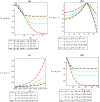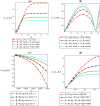Thermomagnetic properties and its effects on Fisher entropy with Schioberg plus Manning-Rosen potential (SPMRP) using Nikiforov-Uvarov functional analysis (NUFA) and supersymmetric quantum mechanics (SUSYQM) methods
- PMID: 37210425
- PMCID: PMC10199953
- DOI: 10.1038/s41598-023-34521-0
Thermomagnetic properties and its effects on Fisher entropy with Schioberg plus Manning-Rosen potential (SPMRP) using Nikiforov-Uvarov functional analysis (NUFA) and supersymmetric quantum mechanics (SUSYQM) methods
Abstract
Thermomagnetic properties, and its effects on Fisher information entropy with Schioberg plus Manning-Rosen potential are studied using NUFA and SUSYQM methods in the presence of the Greene-Aldrich approximation scheme to the centrifugal term. The wave function obtained was used to study Fisher information both in position and momentum spaces for different quantum states by the gamma function and digamma polynomials. The energy equation obtained in a closed form was used to deduce numerical energy spectra, partition function, and other thermomagnetic properties. The results show that with an application of AB and magnetic fields, the numerical energy eigenvalues for different magnetic quantum spins decrease as the quantum state increases and completely removes the degeneracy of the energy spectra. Also, the numerical computation of Fisher information satisfies Fisher information inequality products, indicating that the particles are more localized in the presence of external fields than in their absence, and the trend shows complete localization of quantum mechanical particles in all quantum states. Our potential reduces to Schioberg and Manning-Rosen potentials as special cases. Our potential reduces to Schioberg and Manning-Rosen potentials as special cases. The energy equations obtained from the NUFA and SUSYQM were the same, demonstrating a high level of mathematical precision.
© 2023. The Author(s).
Conflict of interest statement
The authors declare no competing interests.
Figures

















References
-
- Valtchev S, Baikova E, Jorge L. Electromagnetic field as the wireless transporter of energy. F U Elec. Energ. 2012;25:171.
-
- Fisher RA. Theory of statistical estimation. Math. Proc. Cambrid. Philos. Soc. 1925;22:700–725. doi: 10.1017/S0305004100009580. - DOI
-
- Martanez-Flores C. Shannon entropy and Fisher information for endohedral confined one and two electron atoms. Phys. Lett. A. 2021;386:126988. doi: 10.1016/j.physleta.2020.126988. - DOI
-
- Shannon CE. A mathematical theory of communication. Bell Syst. Tech. J. 1948;27:623. doi: 10.1002/j.1538-7305.1948.tb00917.x. - DOI
LinkOut - more resources
Full Text Sources

